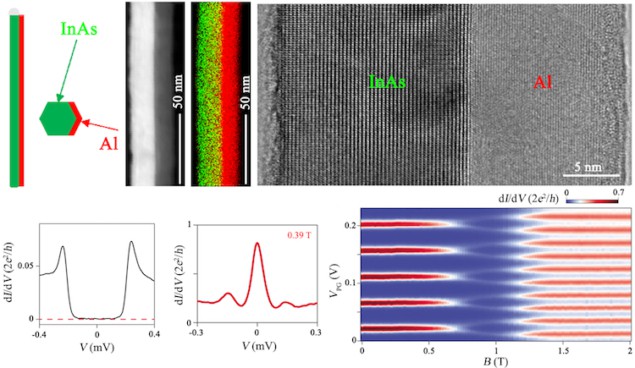Ultrathin nanowires could be a boon for error-resistant quantum computing
27 May 2022 Isabelle Dumé

Researchers have fabricated ultrathin semiconductor-superconductor hybrid nanowires measuring less than 20 nm across. Such wires are thinner than those grown previously and are predicted to host phenomena known as Majorana zero modes – the core ingredient of so-called topological quantum bits (qubits), which could form the basis of a stable and error-resistant quantum computer.
Originally, Majorana zero modes (MZMs) were simply a mathematical construction that allowed an electron to be described theoretically as being composed of two halves. From a quantum computing perspective, they are attractive because if an electron can be “split” in two, the quantum information it encodes will be protected from local perturbations as long as the “half-electrons” can be stored far away from each other. According to theory, these entities should appear in a setup consisting of a semiconducting nanowire wrapped in a shell made from a superconducting material and placed in a magnetic field.
In theory, the simplest type of nanowire in which MZMs should appear is a one-dimensional electron system – that is, one in which electrons occupy a single electronic sub-band in the semiconductor. In experiments, however, multiple sub-bands are occupied. The ultrathin semiconductor-superconductor hybrid nanowires and transport characteristic measurements. (Courtesy: H Zhang)
The ultrathin semiconductor-superconductor hybrid nanowires and transport characteristic measurements. (Courtesy: H Zhang)
 The ultrathin semiconductor-superconductor hybrid nanowires and transport characteristic measurements. (Courtesy: H Zhang)
The ultrathin semiconductor-superconductor hybrid nanowires and transport characteristic measurements. (Courtesy: H Zhang)Diameter of less than 20 nm
In a new study, researchers led by Jianhua Zhao and Dong Pan of the State Key Laboratory of Superlattices and Microstructures, Institute of Semiconductors, Chinese Academy of Sciences, grew ultrathin nanowires of the semiconductor indium arsenide (InAs) covered with an in situ epitaxial superconducting aluminium (Al) film using a technique called molecular–beam epitaxy (MBE). They used a silver (Ag) catalyst to grow the wires – a technique routinely employed in this type of experiment. The new nanowires have a diameter of less than 20 nm, which is five times smaller than semiconductor nanowires previously grown using this approach.
The diameter of the of the wires depends on the diameter of the Ag catalyst, and Zhao explains that very small Ag catalysts (ranging from 5-40 nm) can be prepared using the team’s MBE system. The crystal quality of the wires also depends on their diameter and the wires grown in the new study are of high quality.
New avenue for future MZMs searches
“When combined with Al superconducting films, these ultrathin wires offer a possible way of reaching the fewer sub-band regime (and ultimately the single sub-band regime),” Hao Zhang of Tsinghua University, who led the electron transport measurements in the work, tells Physics World. “These wires therefore open a new avenue for exploring fewer sub-band regimes for future MZMs searches.”READ MORE

Thanks to basic transport characteristic measurements, the researchers have already discovered two phenomena in their system: a “hard” superconducting gap in tunnelling spectroscopy measurements; and a “parity preserving Coulomb blockade” in so-called hybrid island devices. Both phenomena are crucial ingredients for future Majorana searches, Zhang explains.
The team says it is now looking for stronger evidence for MZMs by measuring the quantum transport properties of its ultrathin InAs-Al nanowire structures.
The present work is detailed in Chinese Physics Letters.

Isabelle Dumé is a contributing editor to Physics World
from physicsworld.com 29/5/2022
Δεν υπάρχουν σχόλια:
Δημοσίευση σχολίου